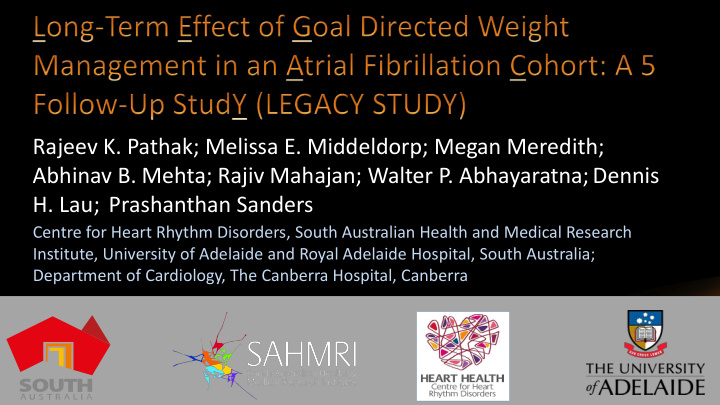



Rajeev K. Pathak; Melissa E. Middeldorp; Megan Meredith; Abhinav B. Mehta; Rajiv Mahajan; Walter P. Abhayaratna; Dennis H. Lau; Prashanthan Sanders Centre for Heart Rhythm Disorders, South Australian Health and Medical Research Institute, University of Adelaide and Royal Adelaide Hospital, South Australia; Department of Cardiology, The Canberra Hospital, Canberra
Proportion overweight 70% 60% 50% USA England 40% Australia 30% France Korea 20% 1982 1992 2002 2012 2022 Years Sassi et.al, OCED Publishing, 2014
HR (CI) 0.25 0 1 2 3 4 5 Metabolic Syndrome 0.2 Component 1.40 Elevated waist 0.15 HR 1.67 CI (1.49-1.87) (1.23-1.59) circumference 1.95 0.1 Elevated blood pressure (1.72-2.21) 0.95 0.05 Elevated triglycerides (0.84-1.09) 1.20 0 Low HDL cholesterol (1.06-1.37) 0 2 4 6 8 10 12 14 16 18 20 1.16 Impaired fasting glucose (1.03-1.31) Chamberlain et al, ARIC Study, AHJ 2010
P<0.001 P<0.001 min Abed et al. JAMA 2013
Weight loss, if sustained, will be of incremental benefit in rhythm control Weight fluctuation has detrimental effect Dose dependent effect of long term weight loss on freedom from AF Impact of weight fluctuation Role of dedicated clinic
Primary Outcomes AF symptom burden: AFSS questionnaire AF freedom: 7 day Holter monitoring Secondary Outcomes Structural parameters: LAV and LV thickness Metabolic and Inflammatory profile
Assessed for Eligibility N=1415 Patients with BMI ≥ 27 Met Exclusion Criteria (N=293) N=825 Terminal Cancer (N=10) Inflammatory Dx (N=20) Permanent AF (N=84) Weight Management AV Node ablation (N=12) AF ablation (N=90) Severe Medical Illness (N=77) Final Cohort Patients from other States (N=177) N=355 3-9%WL ≥10%WL <3%WL or WG N=117 N=103 N=135
≥ 10% Wt Loss <3% Wt Loss 3-9% Wt Loss P Value N= 117 N = 103 N = 135 61 11 63 11 65 11 Age (years) 0.06 Male gender, n (%) 83 (71) 65 (63) 86 (64) 0.4 Non-Paroxysmal AF, n (%) 45 (56) 46 (45) 64 (47) 0.9 32.9 4.8 32.7 4.4 33.6 4.7 BMI 0.2 Hypertension 90 (78) 75 (73) 109 (81) 0.3 DM/IGT, n (%) 34 (29) 28 (27) 41 (30) 0.5 Hyperlipidemia, n (%) 56 (48) 45 (44) 66 (49) 0.7 CAD, n (%) 14 (12) 12 (12) 21 (16) 0.3 AHI>30, n (%) 61 (52) 52 (50) 69 (51) 0.1 Smoker, n (%) 47 (40) 41 (40) 50 (37) 0.9 ETOH (>30g/week), n (%) 34 (29) 35 (34) 42 (31) 0.7
*Group-Time P<0.001 *Group-Time P<0.001 (ml/m 2 ) (mm)
*Group-Time P<0.001 *Group-Time P<0.001
P<0.001 46% 46% Without AAD 22% or ablation 13% Days 0 365 730 1095 1460 1825 ≥ 10%WL 135 101 72 42 31 18 3-9% WL 103 62 36 22 13 7 <3% WL 117 66 44 22 11 9
86% 66% 40% With AAD +/- ablation P<0.001 Days 0 365 730 1095 1460 1825 ≥ 10%WL 135 130 114 86 67 36 3-9% WL 103 93 83 57 35 22 <3% WL 117 105 85 53 32 22
Effect of Yearly Weight Trend Weight Loss Trend (N=344) 110 120 110 115 105 110 100 90 105 95 Linear Weight Weight 100 90 Linear Gain 70 Loss Fluctuation 95 85 N=24 (7%) 80 90 N=141 (41%) N=179 (52%) 50 1 2 3 4 5 1 1 2 2 3 3 4 4 5 5 Years Years Years Effect of Degree of 2-5%WF <2%WF >5%WF N=68 N=54 N=57 Weight fluctuation
76% 59% 38% With AAD +/- ablation P<0.001 Days 0 365 730 1095 1460 1825 Linear Loss 141 130 122 80 52 29 Wt. Fluctuation 179 165 140 99 71 44 Linear Gain 24 20 18 12 8 5
85% 59% 44% With AAD +/- ablation P<0.001 Days 0 365 730 1095 1460 1825 <2% WF 54 52 49 39 33 19 2-5% WF 68 62 54 39 27 15 >5% WF 57 53 45 31 19 14
≥ 10% weight loss was associated >5% weight fluctuation was with AF free survival: HR 5.7 [95% associated with AF recurrence: HR CI: 3.3-10.1] (P<0.001) 2.2 [95% CI: 1.1-4.2](P<0.001)
100 52 patients lost >10% 85% weight in first year 80 Total Patients N=135 Total Patients N=103 Total Patients N=117 WL Clinic 34/52 (66%) maintained WL 113(84%) 57% 60 WL Clinic 30/34 (85%) attended WL WL Clinic 35 (30%) 40 WL Clinic clinic 30% WL Clinic 58 (57%) WL Clinic 18 regained weight, only 2 20 (11%) attended clinic 0 ≥10% WL 3-9 % WL <3% WL
Sustained weight loss is associated with dose dependent reduction in AF burden and maintenance of sinus rhythm >5% Weight fluctuation dampens the benefit conferred by weight loss A dedicated clinic improves patient engagement, promoting treatment adherence, preventing weight regain and fluctuation
Long-Term Effect of Goal Directed Weight Management in an Atrial Fibrillation Cohort: A Long-term Follow-Up StudY (LEGACY STUDY) Simultaneous online publication on 16 March 2015
Recommend
More recommend